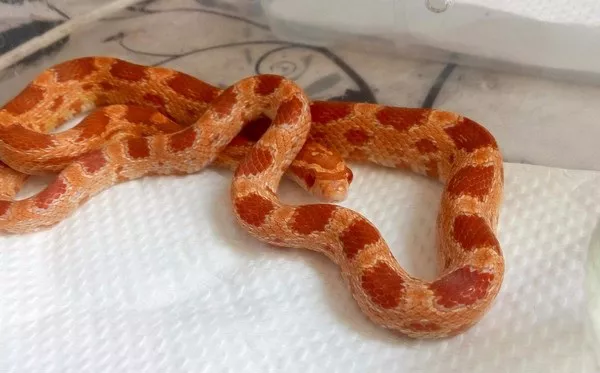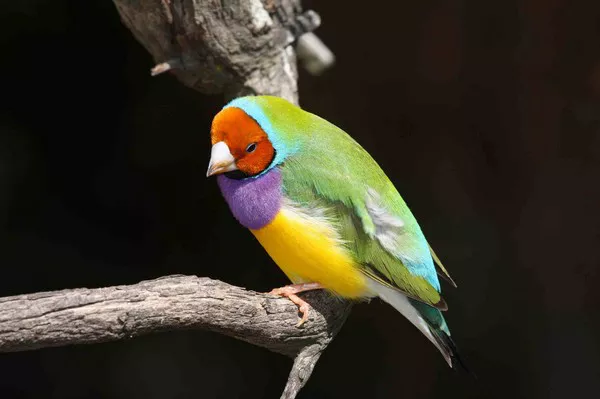Corn snakes, with their striking patterns and relatively docile temperament, are among the most popular pet snakes in the world. Whether you’re a first-time snake owner or an experienced herpetologist, this article will guide you through the essential things you need to know before bringing a corn snake into your home. From understanding their basic needs to setting up their habitat and choosing the right diet, we’ll cover everything that will help ensure a healthy and happy life for your corn snake.
What Are Corn Snakes
Corn snakes (Pantherophis guttatus) are a species of rat snake native to the southeastern United States. They are non-venomous constrictors, meaning they subdue their prey by coiling around it and squeezing rather than using venom. Corn snakes are known for their calm demeanor and are often recommended as a beginner-friendly pet snake.
Corn snakes are named for the pattern of their scales, which resemble the appearance of corn kernels, but their colorful appearance and wide variety of morphs make them stand out as one of the most visually appealing species in the reptile world.
Before purchasing a corn snake, it’s crucial to understand their specific needs and what is involved in their care. Owning a corn snake requires commitment, as they can live up to 20 years or more with proper care.
Are Corn Snakes the Right Pet for You?
Before you buy a corn snake, ask yourself whether you are ready for the responsibility of owning a reptile. Unlike cats or dogs, snakes don’t seek companionship, and their care needs can be quite specific. Corn snakes are generally low-maintenance, but they do require an environment that mimics their natural habitat.
1. Space Requirements
Corn snakes, though relatively small compared to other pet snakes, still need ample space to thrive. Adult corn snakes typically reach lengths of 4 to 5 feet (1.2 to 1.5 meters), and their enclosures should provide enough room for them to move freely.
A 20-gallon tank is generally considered the minimum size for an adult corn snake, although a larger enclosure is always preferable. Corn snakes enjoy having space to climb and explore, so providing branches and hides can make their environment more stimulating.
If you live in a small apartment or a space where you can’t accommodate a large enclosure, you might want to reconsider keeping a snake as a pet.
2. Long-Term Commitment
Corn snakes have long lifespans. In fact, with proper care, they can live between 15 to 20 years, making them a long-term commitment. It’s essential to consider whether you’re prepared to care for your corn snake for the entirety of its life. This includes feeding, cleaning, and maintaining its habitat, along with regular health checks.
3. Careful Handling
While corn snakes are typically docile and calm, they do require gentle handling. Unlike dogs or cats, which may enjoy being petted and cuddled, corn snakes are not animals that thrive on human interaction. They are solitary creatures, so while they can become accustomed to being handled, it should be done with respect for their comfort.
If you’re looking for a pet that enjoys frequent attention and interaction, a corn snake might not be the right choice.
Choosing Your Corn Snake
Once you’ve determined that you’re ready for a corn snake, the next step is choosing one. When purchasing a corn snake, there are several factors to consider, including where to buy it from, its age, and its health.
1. Buying from a Reputable Source
It’s crucial to buy your corn snake from a reputable breeder or pet store. Avoid buying from untrustworthy or questionable sources, as they may not provide healthy snakes or proper documentation on the animal’s breeding or medical history.
When selecting a breeder or store, ensure that they follow ethical breeding practices and provide healthy, well-cared-for animals. A responsible breeder will be knowledgeable about the species and should offer a warranty or return policy in case there are issues with the snake’s health.
2. Health and Appearance
When you’re selecting your corn snake, take time to inspect the snake’s health. Healthy corn snakes should have clear, bright eyes and a smooth, vibrant skin tone. There should be no visible signs of injury, mites, or other external parasites. The snake should be active and alert, not lethargic or unusually thin.
If you’re buying a corn snake from a breeder, ask to see the parents to get an idea of the snake’s potential size and temperament. Ensure that the snake has been fed a proper diet and has had all necessary health checks. Reputable breeders will be transparent about the care their animals have received.
3. Snake Morphs
Corn snakes come in a wide range of colors and patterns due to selective breeding. These are known as “morphs,” and they can vary significantly in appearance. Some popular corn snake morphs include:
- Amel (Albino): A pale, yellow-orange color with red eyes.
- Ghost: A pale, ghostly color with a washed-out appearance.
- Okeetee: Known for their bold orange and black pattern.
- Lavender: A soft, purple-lavender color with unique markings.
While these morphs can be more expensive than wild-type corn snakes, they are still typically affordable compared to other exotic reptiles.
If you have a specific color or pattern in mind, make sure to research the morph and ask the breeder about its availability.
Setting Up the Habitat
Before bringing your corn snake home, you’ll need to set up its habitat. Providing a safe and comfortable environment is essential for the health of your pet. A well-designed enclosure will allow your snake to feel secure and engage in natural behaviors.
1. Choosing the Right Enclosure
As mentioned earlier, a 20-gallon tank is usually the minimum recommended size for a corn snake. A tank made of glass or plastic with a secure lid will provide adequate ventilation while keeping your snake safe. The tank should be long enough for the snake to stretch out and explore.
It’s important that the enclosure is escape-proof, as corn snakes are excellent climbers and can squeeze through even small openings. Secure locks or tightly fitting lids are essential to keep your snake contained.
2. Substrate
The substrate is the material that lines the bottom of the enclosure. It helps maintain humidity, provides comfort for your snake, and absorbs waste. Common substrates for corn snakes include:
- Aspen shavings: A popular, absorbent substrate.
- Coconut fiber: Helps maintain humidity and is safe for your snake.
- Paper towels: Easy to clean and maintain, but not as natural.
Avoid using substrates like sand or gravel, as they can cause impaction if ingested and are difficult to clean.
3. Heating and Temperature
Corn snakes are ectothermic, meaning they rely on external sources of heat to regulate their body temperature. In the wild, they bask in the sun during the day and seek cooler areas at night. To replicate these conditions in captivity, you need to provide both a warm and a cool side to the enclosure.
Use a heat pad or heat lamp to create a temperature gradient, with the warm side ranging between 80–85°F (27–29°C) and the cool side between 70–75°F (21–24°C). A thermostat is crucial to prevent overheating and ensure that the temperature remains stable.
At night, the temperature can drop slightly, but it should not fall below 65°F (18°C).
4. Humidity
Corn snakes require a moderate level of humidity, generally between 40–60%. Too much humidity can lead to respiratory issues, while too little can cause skin shedding problems. You can maintain proper humidity by lightly misting the enclosure or using a humidity gauge to monitor levels.
Adding a shallow water dish will also help increase humidity while providing a drinking source for your snake. Make sure the dish is large enough for your corn snake to soak in if it chooses to do so.
5. Hides and Decorations
Corn snakes feel secure in hiding spots, so it’s essential to provide at least two hides: one on the warm side of the tank and one on the cool side. These hides give your snake a place to retreat when it feels stressed or wants to sleep. Hides can be commercially available or made from materials like PVC pipes, plastic boxes, or ceramic caves.
Decorative elements like branches, rocks, and artificial plants can also make the environment more stimulating. However, ensure that any decoration is smooth and free from sharp edges to prevent injury.
Feeding Your Corn Snake
Corn snakes are carnivores, and their diet primarily consists of rodents like mice and rats. It’s important to feed them appropriately-sized prey to ensure they remain healthy.
1. Frequency of Feeding
Young corn snakes typically need to be fed once a week, while adults can be fed every 10–14 days. The size of the prey should be appropriate to the size of the snake; a good rule of thumb is to feed a mouse or rat that is about the same size as the snake’s girth.
Avoid feeding your snake prey that is too large, as it can cause digestive issues. Likewise, avoid feeding prey that is too small, as it won’t provide the necessary nutrients.
2. Pre-killed vs. Live Prey
Many snake owners opt for pre-killed or frozen-thawed rodents because live prey can be dangerous. A live rodent can potentially harm your snake, and it also poses the risk of injury to the snake during the hunting process. Pre-killed prey is safer, easier to handle, and ensures the rodent doesn’t inflict harm.
When feeding, use tongs or forceps to offer the prey, as this mimics the snake’s natural hunting behavior and avoids human scent on the food.
3. Hydration
Along with regular feeding, it’s crucial that your corn snake has access to fresh, clean water at all times. A shallow water dish should be provided in the enclosure, and it should be changed regularly to prevent contamination.
Health and Veterinary Care
Although corn snakes are generally hardy, they are still susceptible to various health issues. Common health concerns in corn snakes include respiratory infections, mites, and shedding problems. If you notice any unusual behavior or signs of illness, it’s important to seek veterinary care.
1. Shedding
Corn snakes, like all reptiles, shed their skin as they grow. This process typically occurs every 4 to 6 weeks, but it can be more frequent in younger snakes. Ensure that the humidity in the enclosure is at the correct level to help with the shedding process.
If your snake is having trouble shedding, you can help by increasing humidity or providing a shedding box (a moist hide) to help the skin come off more easily.
2. Parasites
Corn snakes can occasionally develop external parasites, such as mites. Mites are tiny, black insects that feed on the snake’s blood. If you notice your snake rubbing its body or excessive shedding, it may have mites. Mite infestations can be treated with appropriate veterinary care and mite treatments.
Conclusion
Corn snakes are fascinating and low-maintenance pets, making them an excellent choice for many reptile enthusiasts. However, like all pets, they require a significant amount of care and attention. Before bringing a corn snake into your home, ensure you have the appropriate space, equipment, and commitment to provide a healthy environment for your new pet.
With proper care, a corn snake can live a long, healthy life, bringing joy and fascination to your home for many years. Whether you choose a wild-type corn snake or one of the stunning morphs, the key to their well-being lies in providing the right habitat, diet, and medical care.
By following the information in this guide, you’ll be well-prepared to provide your corn snake with a fulfilling life as a beloved companion.
Related Topics:























